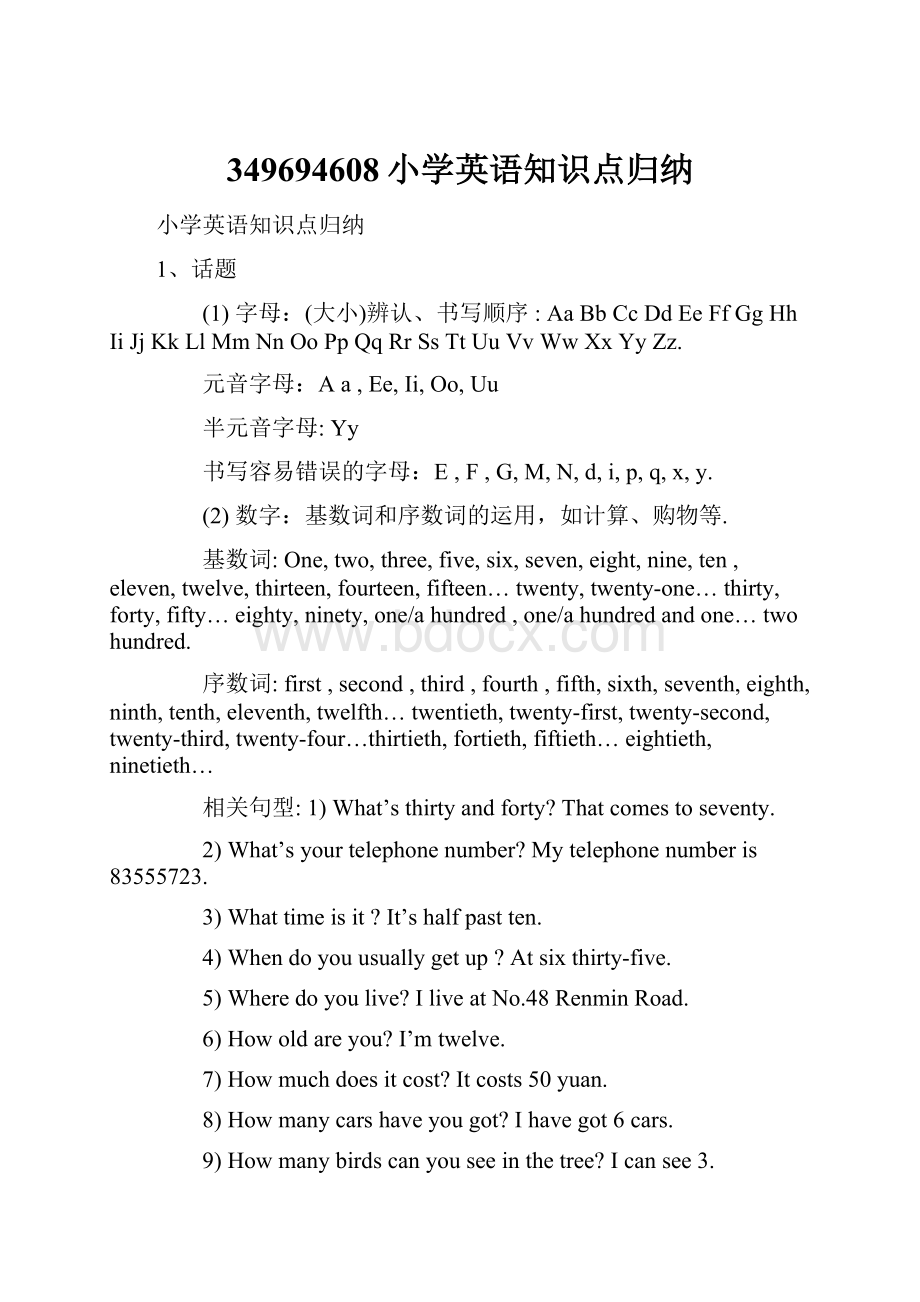349694608小学英语知识点归纳.docx
《349694608小学英语知识点归纳.docx》由会员分享,可在线阅读,更多相关《349694608小学英语知识点归纳.docx(25页珍藏版)》请在冰豆网上搜索。

349694608小学英语知识点归纳
小学英语知识点归纳
1、话题
(1)字母:
(大小)辨认、书写顺序:
AaBbCcDdEeFfGgHhIiJjKkLlMmNnOoPpQqRrSsTtUuVvWwXxYyZz.
元音字母:
Aa,Ee,Ii,Oo,Uu
半元音字母:
Yy
书写容易错误的字母:
E,F,G,M,N,d,i,p,q,x,y.
(2)数字:
基数词和序数词的运用,如计算、购物等.
基数词:
One,two,three,five,six,seven,eight,nine,ten,eleven,twelve,thirteen,fourteen,fifteen…twenty,twenty-one…thirty,forty,fifty…eighty,ninety,one/ahundred,one/ahundredandone…twohundred.
序数词:
first,second,third,fourth,fifth,sixth,seventh,eighth,ninth,tenth,eleventh,twelfth…twentieth,twenty-first,twenty-second,twenty-third,twenty-four…thirtieth,fortieth,fiftieth…eightieth,ninetieth…
相关句型:
1)What’sthirtyandforty?
Thatcomestoseventy.
2)What’syourtelephonenumber?
Mytelephonenumberis83555723.
3)Whattimeisit?
It’shalfpastten.
4)Whendoyouusuallygetup?
Atsixthirty-five.
5)Wheredoyoulive?
IliveatNo.48RenminRoad.
6)Howoldareyou?
I’mtwelve.
7)Howmuchdoesitcost?
Itcosts50yuan.
8)Howmanycarshaveyougot?
Ihavegot6cars.
9)Howmanybirdscanyouseeinthetree?
Icansee3.
10)Howmanydollsarethereonthebed?
Thereisone/adoll.
11)Howmanydollsarethereonthebed?
Therearefourdolls.
12)Whichfloordoyouliveon?
Iliveonthefifthfloor.
13)Excuseme,canyoutellmethewaytoBaiyunhotel?
Yes,godownthisstreet,thenturnleftatthethirdcrossing….
14)Who’sthefifthgirlfromtheright?
She’smycousin.
注意:
数词的应用;不可数名词及它的量的表示方法;many与much在用法上的区别;thereis/are与have/has在用法上的区别.
(3)颜色:
实物的颜色
colours:
red,pink,yellow,brown,blue,purple,orange,black,white,grey,darkblue,lightblue.
相关句型:
1)Whatcolourisyourcoat?
It’s...
2)What’syourfavouritecolour?
Myfavouritecolouris…
(4)时间:
年、季节、月、星期、日、时刻
year,season(spring,summer,autumn,winter),
month:
January,February,March,April,May,June,July,August,September,October,November,December.
Week:
Sunday,Monday,Tuesday,Wednesday,Thursday,Friday,Saturday.
Day:
1stMay(thefirstofMay),May2nd(Maythesecond)
Time:
(an)hour,minute,second
10:
05(fiveminutespastten,tenofive)
10:
10(tenminutespastten,tenten)
10:
15(quarterpastten,tenfifteen)
10:
30(halfpastten,tenthirty)
10:
45(quartertoeleven,tenforty-five)
11:
00(eleveno’clock)
相关句型:
1)Howoldisyourmother?
She’sthirty-sixyearsold.
2)Howmanymonthsarethereinayear?
Thereare12.
3)When’syourbirthday?
Mybirthdayison15thJanuary(thefifteenthofJanuary).
4)Whendoyougetup?
Igetupatsixo’clock.
5)Whendoesspringlast?
Itlastsfor3monthsfromMarchtoMay.
6)Whattimeisit?
It’squartertonine.
(5)食品与饮料:
人对食品与饮料的喜好;东西方食品
food:
meat,rice,fish,bread,egg,cake,
drinks:
water,milk,orange/apple/watermelon/banana/strawberryjuice,coke,coffee,black/greentea…
相关句型:
1)Wouldyoulikesomethingtodrink/eat?
Yes,I’dlikesome…
No,thanks.
2)Wouldyouliketoeat/drink?
I’dliketoeat/drink…
No,thanks.
3)What’syourfavouritefood/drink?
Myfavouritefood/drinkis…
4)CouldIhavesome…?
Yes,please.
(6)服装:
服装的颜色:
人对服装的喜好;某人的穿戴;
所属关系
clothes:
hat,cap,coat,shirt,T-shirt,skirt,dress,sweater,jacket,trousers,sock,shoe
puton,wear
所属关系:
形容词性的物主代词:
my,your,his,her,its,our,their
名词性的物主代词:
mine,yours,his,hers,its,ours,theirs
相关句型:
1)Whatdoesitlooklike?
Itlikeswearingablueshirt.
2)Whoseshoesarethese?
They’remine.
They’reTom’s.
3)Isthis/that/ityourbook?
Yes,itis.
No,itisn’t.
4)Isthispencilyours?
Yes,itis.No,itisn’t.
5)Arethese/those/theyyourcoatsandtrousers?
Yes,theyare.No,theyaren’t.
6)Arethoseclothestheirs?
Yes,theyare.
No,theyaren’t.
7)Thisismyhat.Thathatishis.
注意:
名词单,复数;物主代词(名词性的物主代词,形容词性的物主代词);名词所有格,如:
Tom’s,myfather’s,theteachers’.
(7)玩具和文具:
特点、颜色、所属关系;存在的位置
Toys:
doll,toy…
文具:
desk,book,bag,pen,pencil,pencil-box,ruler,chair,ball
存在的位置:
in,on,under,beside,behind,infrontof,inthefrontof,inthemiddleof,atthebackof…(aplace/aperson).
相关句型:
1)Thereisacupofteaonthetable.
2)Therearesomeorangesinthefridge.
3)Isthereanymilkintheglass?
Yes,thereis.
No,thereisn’t.
4)Arethereanyorangesinthefridges?
Yes,thereare.No,therearen’t.
5)What’sunderthedesk?
Thereisanorange./Therearesomeoranges.
(8)日常生活用品:
特点、颜色、所属关系;存在的位置
words:
shelf,table,clock,brush,telephone,light,computer,bike,fridge,glass,knife,keyboard,bottle,box,plate,photo,photograph,fax,radio,super-market,bookstore,noodles/cake/clothes/shoe/TVshop.
特点:
big,small,heavy,light,white,black,empty,full,old,new,beautiful,cute,tall,short,strong,plump,nice,good,bad…
(9)动物:
家畜、家禽;农场动物、动物园及野生动物的特点;生活地点和所属关系
words(animals):
cat,dog,duck,goose(geese)fish,sheep,bird,panda,monkey,rabbit,hen,cock,chicken,tiger,lion,pig,cow,mouse(mice),giraffe,dolphin,
生活地点:
athome,inafarm,inazoo…
所属关系:
同上话题(7)
(10)植物:
特点、所属关系;存在的位置
words:
tree,rose,flower,leaf(leaves)…
(11)环境与建筑:
特点、所属关系;存在的位置
buildings:
factory,hospital,park,house,library,museum,office,farm,postoffice,bank,policestation,trainstation,sportsstadium,departmentstore,store,school,classroom,house:
bathroom,living-room,sitting-room,bedroom,washroom,kitchen,garden…
房子的基本构造:
door,gate,wall,window,floor…
相关句型:
1)Wheredoyoustudyat?
IstudyatLongdongPrimarySchool.
2)Wheredoesyourmotherworkat?
Sheworksatahospital.
3)Let’smeetatthegateofthepark.
4)Mybrotherisplayinginthegarden.
(12)身体:
特点
body:
head,hair,eye,nose,ear,mouth,neck,shoulder,hand,finger,foot(feet),toe…
外貌:
fat,thin,plump,tall,short,old,young,roundface,twobigblueeyes,longhair,shorthair,blackhair,whitehair…
相关句型:
1)I’m/You’re/He’s/She’s/We’re/They’re(not)tall.
2)Ishe/shetallorshort?
He’s/She’stall(short).
3)I/We/They/Youhave(got)blackhair.
4)He/Shehas(got)aroundface.
5)Hashe/shegotlonghair?
Yes,he/shehas.
No,he/shehasn’t.
注意:
描述人的外貌时,have与has用法上的区别;形容词的用法,如:
tall,short,old,young,black,long…
(13)个人情况:
姓名、年龄、地址、特点与爱好
age,year,address,e-mailaddress,hobby,
hobby:
collectingstamps(coins),goingswimming…doingsth
相关句型:
1)Howoldareyou?
I’mthirteenyearsold.
2)I’mathirteen-yearoldboy.
3)What’syouraddress?
IliveatNo.48Renminroad.
4)What’syoure-mailaddress?
Mye-mailaddressis123VIP@.
5)What’syourhobby?
Myhobbyisgoingrunning.
Or:
Ilikegoingrunning.
6)I/You/Theylikemusic.
7)Helikessightseeing.
8)Doyoulikereading?
Yes,Ido.No,Idon’t.
9)Doeshe/shelikeplayingbasketball?
Yes,he/shedoes.No,he/shedoesn’t.
注意:
描述个人的喜好时:
名词和动词-ing形式作宾语;主语是第三人称单数时一般现在时动词的变化。
动词ing的变化规律:
1)直接加ing,如:
open-opening,clean-cleaning,meet-meeting,sing-singing,study-studying,…
2)去掉词尾不发音的e,如:
take-taking,close-closing,come-coming,drive-driving,have-having,use-using,write-writing,practice-practicing,…
3)重读闭音节的,双写最后的字母,加ing,如:
sit-sitting,put-putting,begin-beginning,get-getting,swim-swimming,run-running,cut-cutting,become-becoming,…
主语是第三人称单数时一般现在时动词的变化规律(与名词变复数规律相同):
1)直接加s,如:
cook-cooks,come-comes,close-closes,…
2)以o,x,s,sh,ch结尾+es,如:
teach-teaches,go-goes,do-does,catch-catches,wash-washes,brush-brushes,miss-misses,…
3)辅音字母加y结尾,把y改为i,+es,如:
fly-flies,worry-worries,carry-carries,…
4)以f或fe结尾,把f或fe,改为v+es.
5)特殊:
have-has,…
(14)家庭、亲属和朋友:
姓名、年龄、地址、特点与爱
好:
与你的关系
words:
family,grandfather(grandpa/granddad),grandmother(grandma/grandmum),father,mother,brother,sister,uncle,aunt,cousin,friend
相关句型:
1)Ishe/sheTom’scousin?
Yes,he/sheis.
No,he/sheisn’t.
2)Who’she/she?
He’s/She’smyfriend.
3)Howmanypeoplearethereinyourfamily?
Whoarethey?
Therearefour,myfather,mymother,mybrotherandme.
注意:
1)名词单复数,如:
family-families;
名词单数--复数规律:
1)直接加s,如:
boy-boys,term-terms,
2)以o,x,s,sh,ch结尾+es,如:
box-boxes,class-classes,glass-glasses,coach-coaches,dress-dresses,fax-faxes,inch-inches,match-matches,
3)辅音字母加y结尾,把y改为i,+es,如:
baby-babies,lady-ladies,factory-factories,peach-peaches,library-libraries,watch-watches,
4)以f或fe结尾,把f或fe,改为v+es:
leaf-leaves,knife-knives,wife-wives,shelf-shelves,…
5)特殊:
man-men,policeman-policemen,woman-women,child-children,goose-geese,tooth-teeth,foot-feet,
6)不变:
hair,milk,tea,coffee,water,bread,rice,paper,juice,meat,people,fish,sheep,…
2)名词所有格,表明是“谁的”如:
mycousin’s,hisparents’
它的构成规则:
单数名词后+“’s”,Mike’smother.
复数名词词尾有,其后只+“’”,Teachers’Da教师节.
若是两人共有时,只在后者+“’s”,
JimandTom’smother.吉姆和汤姆的母亲。
不是两者所共有的,两者都+“’s”,
Jim’sandTom’smother.吉姆母亲和汤姆的母亲。
名词若是无生命,所有格构成用of,
amapofChina.一幅中国地图
(15)学校:
学校建筑和学校生活
words:
schoolbuilding,classroom,dormitory,playground,library…
subjects:
Chinese,maths,English,music,computer,PE,art,biology,politics,history,meeting,geography…
相关句型:
1)What’syourfavouritesubject?
English.
2)Where’sthelibrary?
It’sbehindthedormitory.
3)Whendoyougotoschool?
At7:
20.
4)WhendoesChinesebeginonMonday?
AtEighto’clock.
5)DoesgeographybeginattwentytotenonMonday?
Yes,itdoes.No,itdoesn’t.
6)We’rehavinganEnglishclass.
(16)社交礼仪:
礼貌用语;询问与应答
1.Greetings:
Hello!
Hi!
Goodmorning/afternoon/evening.
Howareyou?
Fine,thanks.Andyou?
Pleasesayhellotoyourparentsforme.
2.Introduction:
Mynameis…I’mapupil.I’mnewhere.